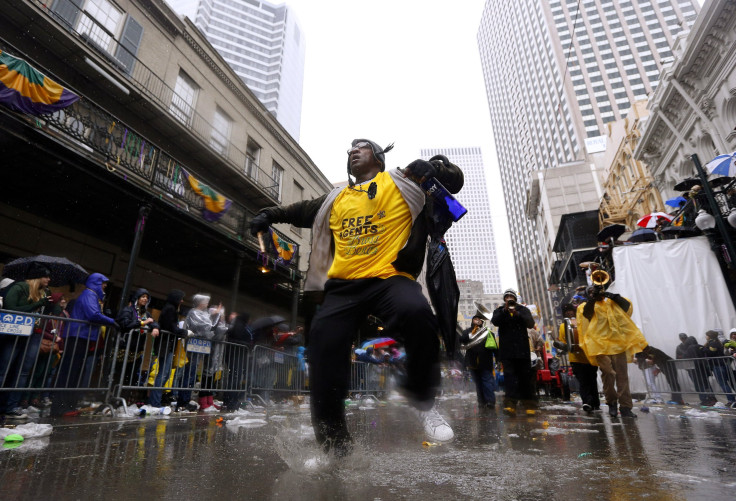What The Tax Returns Of Hurricane Katrina Victims Say About Long-Term Recovery From Natural Disasters

Despite the major economic shock that Hurricane Katrina delivered to New Orleans in August 2005, the average income among the city’s affected residents not only caught up to, but eventually outpaced earnings in other cities within three years, a new study finds.
The study shows Katrina victims’ average wage income fell by $1,600 the year of the storm, and by $2,200 the next year, 2006. But by 2008, the average hurricane victim was earning more than the average person from a control group outside New Orleans. And, by the end of the sample period, in 2010, hurricane victims were earning more than the control group’s member by nearly $3,000 per year.
“Most people would have thought that, given the magnitude of this event, and the chaotic upturn of people’s lives, that they wouldn’t have recovered so quickly,” says Tatyana Deryugina, an assistant professor of finance at the University of Illinois at Urbana-Champaign, who co-authored the working paper released by the National Bureau of Economic Research this week.
Unemployment-insurance benefits followed a similar pattern. New Orleans residents were 26 percent more likely to collect unemployment benefits in 2005, and 11 percent more likely to claim those benefits in 2006. However, “the spike in employment receipts is short-lived,” the paper finds. From 2007 to 2010, “New Orleans residents are two to three percentage points less likely to receive unemployment benefits.”
The paper is one of the first of its kind to look beyond the immediate aftermath of a natural disaster and track its economic impacts over time.
Hurricane Katrina caused more than $100 billion worth of property damage. It displaced residents and brought businesses and tourism to a halt. And yet, Deryugina says, “we actually know very little about what happens to disaster victims in the long run.”
Gathering economic data is critical to debates on disaster relief and climate change, the paper argues. “The impact of a disaster is the sum of its impact over your whole life span,” Deryugina says. She conducted the research with Laura Kawano of the U.S. Treasury Department and “Freakonomics” author Steven Levitt.
“If you were 35 when Hurricane Katrina hit, and the storm affected your lifetime earnings potential, that’s a huge deal,” Deryugina says.
To capture this data, the authors analyzed individual tax returns filed between 1999 and 2010. They classified those New Orleans households that filed returns in 2004 as “victims” of the 2005 storm, and they were able to track them through the years even if they left the city after the hurricane. The authors compared these hurricane victims with a control group drawn from cities similar to New Orleans in racial composition, earnings trajectories and employment rate.
The tax returns indicated that household savings were important for cushioning the fallout, finding that “households, on average, took significant distributions from their retirement accounts in 2005-2010, taking advantage of a special exemption from the early withdrawal penalty.”
The study also shows the level of property damage in a resident’s neighborhood was one of the most important predictors of future income. Findings show “a high degree of correlation between the extent of physical damage caused by the storm and the negative impact on labor earnings of residents in those areas.”
Residents who lived in the least affected areas experienced “no significant wage drop” after Katrina hit, and by 2010 their wage incomes grew about $4,500 higher than those in the control group, the study shows.
People from the areas with the most storm damage, which the Federal Emergency Management Agency labeled “look and leave” ZIP codes, took the hardest hit to their earnings: “Their wage incomes are on average $2,600 lower in the year of Hurricane Katrina and about $5,100 lower the year after that,” the study finds. But in 2007 their incomes began to increase again, and by 2010 “look and leave” residents were “earning as much as the control group, though significantly less than the rest of New Orleans.”
A second group of residents belonged to “look and stay” neighborhoods, meaning they were allowed to return to live in their homes three-and-a-half months after the hurricane. “Look and stay” neighborhoods saw their wage incomes slide $1,300 in 2005 and $1,100 in 2006. But five years removed from Katrina, they were earning $4,700 more than the control group members outside the city.
Deryugina points to other factors that could help explain the missing “wage bump” in those neighborhoods with the worst damage. Those areas were already poorer than other parts of the city, for one, and people living in the neighborhoods with significant storm damage also worked in neighborhoods that were largely impacted.
As for why the average wage of hurricane victims increased, the study points to increases in the cost of living as the main driver of higher pay. Relative to control cities, housing prices were nearly 15 percent higher in New Orleans by 2010, a differential that “almost exactly corresponds to the observed increase in wage income,” the paper says.
Those who came back to the city also fared better than those who left, and the study finds “the increase in wage earnings was concentrated among those who eventually returned to New Orleans.”
In addition to the $100 billion in direct disaster relief, and $4.25 billion in charitable donations, the paper cites policies that expanded the availability of unemployment insurance, created tax incentives for businesses to hire and allowed residents to make early withdrawals from retirement accounts without facing penalties as the prime mitigating forces. “While our study cannot precisely identify what would have happened in the absence of this aid,” the authors say, “it appears to have been adequate to avert harmful long-run economic effects.”
The study’s authors are quick to point out these data can measure only victims’ monetary well-being, not their life satisfaction or their health, although Deryugina says she plans to study that next.
© Copyright IBTimes 2024. All rights reserved.




















